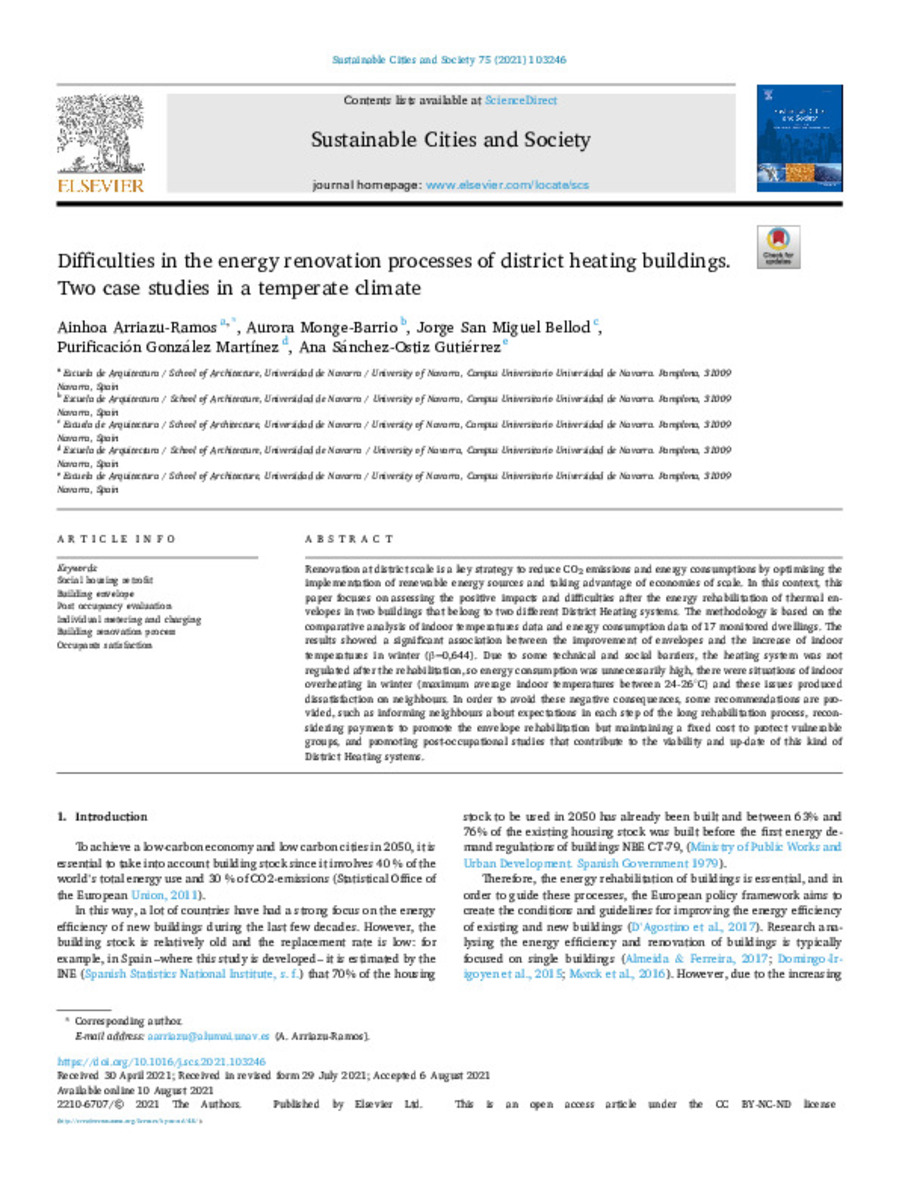Full metadata record
| DC Field | Value | Language |
|---|---|---|
| dc.creator | Arriazu-Ramos, A. (Ainhoa) | - |
| dc.creator | Monge-Barrio, A. (Aurora) | - |
| dc.creator | San-Miguel-Bellod, J. (Jorge) | - |
| dc.creator | González-Martinez, P. (Purificación) | - |
| dc.creator | Sánchez-Ostiz, A. (Ana) | - |
| dc.date.accessioned | 2021-09-07T08:51:31Z | - |
| dc.date.available | 2021-09-07T08:51:31Z | - |
| dc.date.issued | 2021 | - |
| dc.identifier.citation | Arriazu-Ramos, A. (Ainhoa); Monge-Barrio, A. (Aurora); San-Miguel-Bellod, J. (Jorge); et al. "Difficulties in the energy renovation processes of district heating buildings. Two case studies in a temperate climate". Sustainable Cities and Society. 75, 2021, 103246 | es |
| dc.identifier.issn | 2210-6707 | - |
| dc.identifier.uri | https://hdl.handle.net/10171/61941 | - |
| dc.description.abstract | Renovation at district scale is a key strategy to reduce CO2 emissions and energy consumptions by optimising the implementation of renewable energy sources and taking advantage of economies of scale. In this context, this paper focuses on assessing the positive impacts and difficulties after the energy rehabilitation of thermal envelopes in two buildings that belong to two different District Heating systems. The methodology is based on the comparative analysis of indoor temperatures data and energy consumption data of 17 monitored dwellings. The results showed a significant association between the improvement of envelopes and the increase of indoor temperatures in winter (β=0,644). Due to some technical and social barriers, the heating system was not regulated after the rehabilitation, so energy consumption was unnecessarily high, there were situations of indoor overheating in winter (maximum average indoor temperatures between 24-26°C) and these issues produced dissatisfaction on neighbours. In order to avoid these negative consequences, some recommendations are provided, such as informing neighbours about expectations in each step of the long rehabilitation process, reconsidering payments to promote the envelope rehabilitation but maintaining a fixed cost to protect vulnerable groups, and promoting post-occupational studies that contribute to the viability and up-date of this kind of District Heating systems. | es_ES |
| dc.description.sponsorship | This study was funded by the Research Contract with NASUVINSA (Social Housing Agency of the Navarra Government), called “Monitoring of social buildings promoted or managed by NASUVINSA”. | es_ES |
| dc.language.iso | eng | es_ES |
| dc.publisher | Elsevier | es_ES |
| dc.rights | info:eu-repo/semantics/openAccess | es_ES |
| dc.subject | Materias Investigacion::Arquitectura | es_ES |
| dc.subject | Social housing retrofit | es_ES |
| dc.subject | Building envelope | es_ES |
| dc.subject | Post occupancy evaluation | es_ES |
| dc.subject | Individual metering and charging | es_ES |
| dc.subject | Building renovation process | es_ES |
| dc.subject | Occupants satisfaction | es_ES |
| dc.title | Difficulties in the energy renovation processes of district heating buildings. Two case studies in a temperate climate | es_ES |
| dc.type | info:eu-repo/semantics/article | es_ES |
| dc.description.note | This is an open access article under the CC BY-NC-ND license. | es_ES |
| dc.identifier.doi | 10.1016/j.scs.2021.103246 | - |
| dadun.citation.publicationName | Sustainable Cities and Society | es_ES |
| dadun.citation.startingPage | 103246 | es_ES |
| dadun.citation.volume | 75 | es_ES |
Files in This Item:
Statistics and impact
Items in Dadun are protected by copyright, with all rights reserved, unless otherwise indicated.






